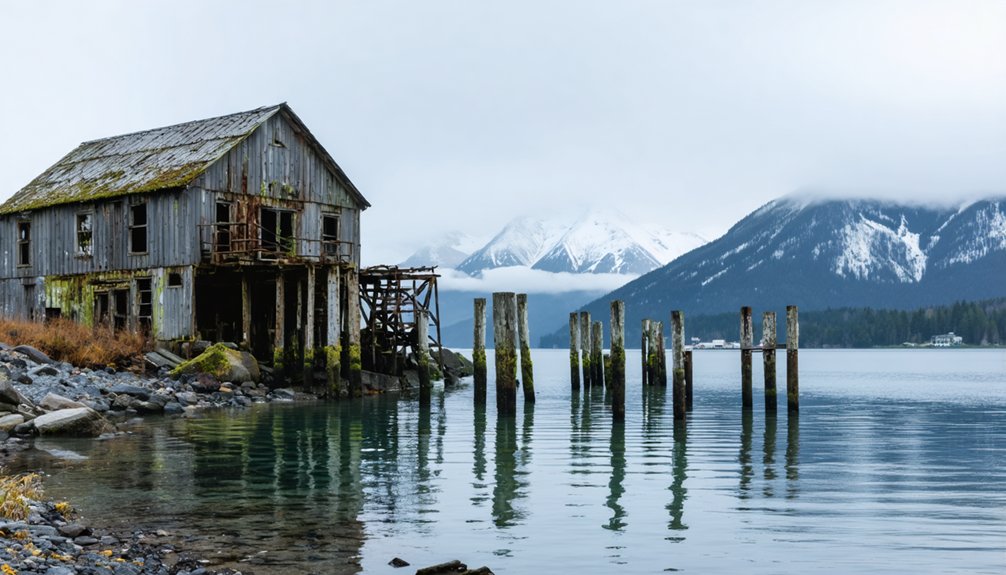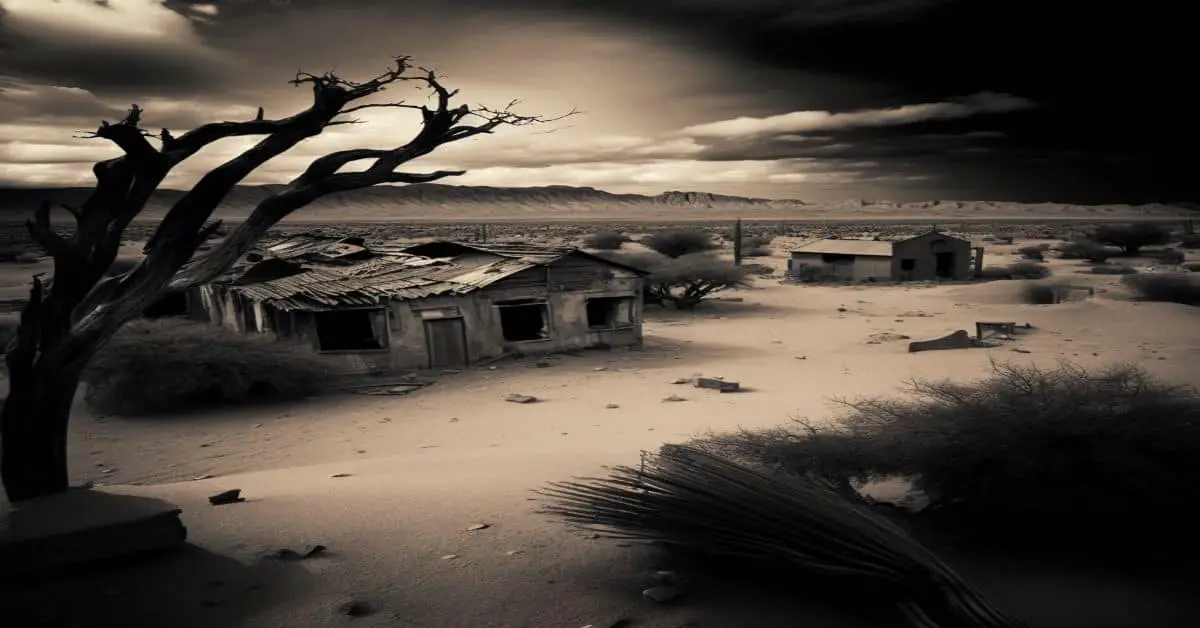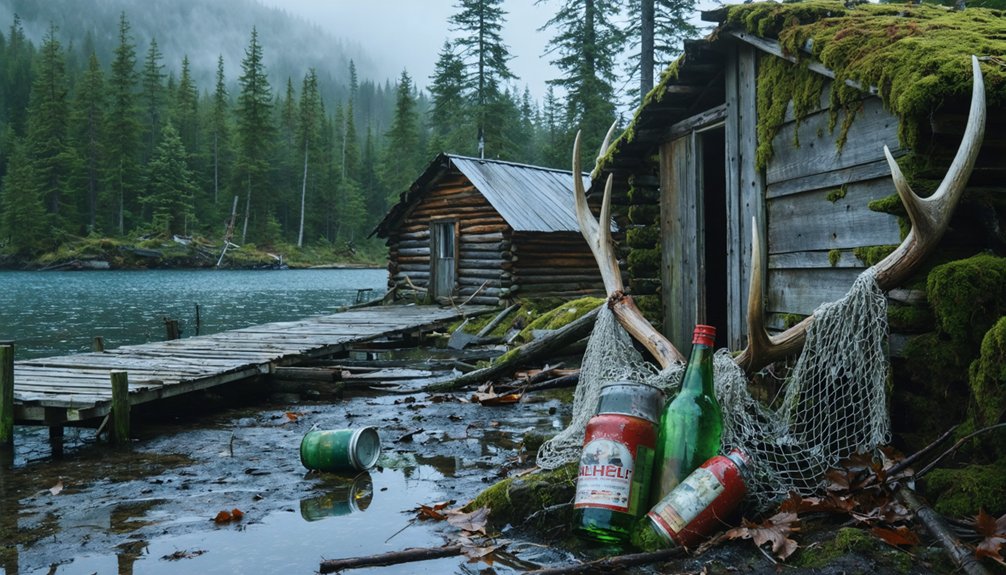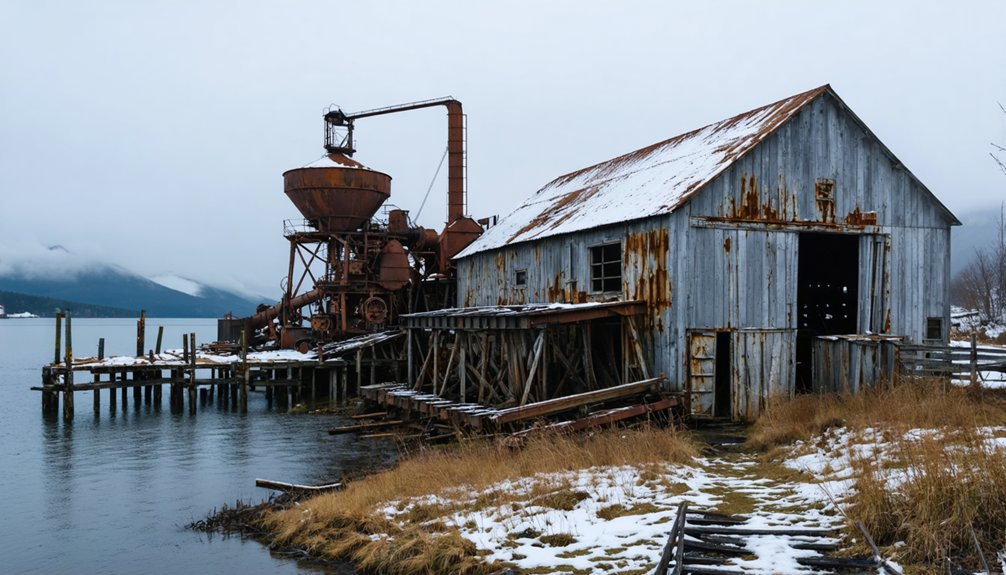You’ll find Portlock’s abandoned remains nestled along Port Chatham Bay on Alaska’s Kenai Peninsula. This once-thriving cannery town, established in the early 1900s, was home to Russian-Aleut families and settlers who built their lives around the salmon industry. In 1950, the entire population mysteriously abandoned the settlement, with many citing encounters with Nantiinaq, a legendary creature from Sugpiaq tradition. The rusting cannery equipment and deteriorating buildings hold secrets of what really drove everyone away.
Key Takeaways
- Portlock was a thriving Alaskan cannery town established in the early 1900s that became completely abandoned by 1950.
- The town’s abandonment was reportedly caused by a creature called Nantiinaq, which allegedly caused numerous disappearances and deaths.
- Today, Portlock’s remains include deteriorating cannery buildings and rusted machinery, accessible only by boat.
- The community consisted mainly of Russian-Aleut people who relocated to nearby towns after the mass exodus.
- Prior to abandonment, the town had a post office, territorial school, and successful salmon industry supporting its population.
The Rise of a Coastal Cannery Town
In the early 20th century, Portlock emerged as an essential cannery town on the southern edge of Alaska’s Kenai Peninsula, nestled within Port Chatham Bay.
You’d find a diverse community of Russian-Aleuts and settlers who built their lives around the thriving salmon industry, employing the latest cannery innovations to process their catches efficiently.
The town’s name originates from a common English surname, which appears frequently in historical records across different regions.
The village grew substantially following the establishment of a salmon cannery and had enough residents to warrant a post office by 1921.
Native Heritage and Early Settlement
As European and American traders arrived in the late 18th century, Sugpiaq traditions endured despite cultural changes.
The local people adapted while preserving their identity, serving as skilled intermediaries in the growing fur trade. Their spiritual beliefs, including stories of the forest spirit *Nantiinaq*, remained essential to the community’s cultural fabric. Initial interactions relied on basic hand gestures due to significant language barriers between the groups.
Even as the settlement transformed into a cannery town, the Sugpiaq influence remained strong through labor, knowledge, and continued presence in the region. The area was first established by Captain Nathanial Portlock in 1786, marking the beginning of increased European presence in the region.
Daily Life in Portlock’s Golden Years
If you’d visited Portlock during its peak years, you’d have found daily life revolving around the rhythms of the cannery’s operations and seasonal fishing cycles.
You’d see families gathering at community events hosted at the territorial school, while work crews coordinated their schedules around tide patterns and salmon runs. Similar to the wealthy Klondike miners, some prosperous cannery workers spent lavishly during successful fishing seasons. The town’s Russian-Aleut population maintained strong cultural traditions throughout their time there.
The town’s isolation meant residents formed tight social bonds through shared labor at the cannery, group hunting expeditions, and essential activities like boat maintenance and food preservation.
Community Gathering and Events
During Portlock’s thriving years, the small Alaskan community fostered a rich tapestry of social gatherings that reflected its diverse Alutiiq and Russian-Aleut heritage.
You’d find yourself drawn to evening storytelling sessions where elders shared ancient legends and survival wisdom, while traditional celebrations marked the changing seasons and successful hunting expeditions.
As part of this close-knit community, you’d join group fishing excursions and participate in traditional Native Alaskan games that strengthened social bonds. The town’s fish cannery workers contributed significantly to these community activities until 1905.
The town’s limited public spaces became vibrant centers of activity during harvest festivals, where you’d experience the blending of Alutiiq and Russian-Aleut customs.
Despite the isolation of the Kenai Peninsula, these gatherings created a strong sense of unity and cultural preservation among Portlock’s resilient inhabitants. The community’s peaceful way of life continued until the mysterious disappearances of the 1940s changed everything.
Work and Daily Routines
Life in Portlock revolved around the bustling salmon cannery, where you’d find Russian-Aleut workers skillfully cleaning, salting, and packing the day’s catch throughout the summer months.
When you weren’t engaged in cannery labor, you’d spend your time fishing for sustenance, using both traditional techniques and modern equipment to secure your family’s food supply.
Your daily routine would include maintaining your boat, mending fishing gear, and preserving food through smoking, drying, or salting.
You’d need to stay alert to weather conditions and tides for safe coastal travel.
Women typically managed household duties while men focused on fishing and hunting.
The isolation meant you’d have to be self-sufficient, crafting and repairing most of what you needed, always mindful of the surrounding wilderness and its inherent dangers.
The Legend of the Nantiinaq
Among Alaska’s most chilling folklore, the Nantiinaq stands as a powerful figure in Sugpiaq (Alutiiq) tradition, particularly around the abandoned settlement of Portlock.
You’ll find accounts of this legendary “hairy man” deeply woven into the region’s history, where Nantiinaq sightings terrorized local inhabitants from 1867 onwards. The creature, described as a giant humanoid with supernatural abilities, reportedly stalked the foggy forests around Port Chatham, leading to numerous disappearances and deaths. The San Francisco Chronicle documented violent attacks that plagued the Sugpiaq community.
The impact of these encounters proved so severe that residents enforced strict curfews and armed patrols. Despite these precautions, the community’s fear culminated in a mass exodus in 1950, when the entire population abandoned Portlock almost overnight.
Today, folklore preservation efforts continue through media coverage and oral histories, keeping the haunting legacy of the Nantiinaq alive. The Discovery Channel’s Alaska Killer Bigfoot series has brought renewed attention to these mysterious events.
Mysterious Disappearances and Strange Events
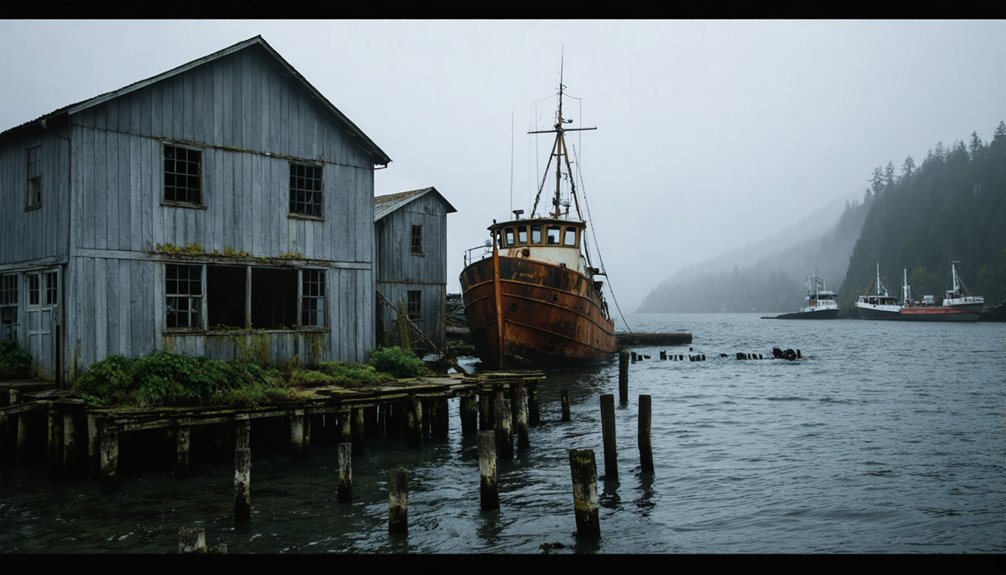
If you’d traveled through Portlock during its decline, you would’ve encountered numerous reports of hunters and trappers vanishing without explanation in the surrounding wilderness.
You might’ve heard whispers about a white-faced woman in black who haunted the coastal cliffs, her screams echoing across the bay before she disappeared into the rock face.
The abandoned mining tunnels held their own mysteries, with locals reporting strange encounters and unexplained sounds that added to the growing list of supernatural occurrences driving residents away from the once-thriving cannery town.
Vanishing Hunters and Trappers
- Survivors reported violent encounters with a massive, hairy beast that stalked the outskirts.
- Bodies were discovered in ritualistic conditions, suggesting calculated violence rather than animal attacks.
- Strange phenomena accompanied the vanishings, including uprooted trees placed upside down and bone-chilling screams.
- Andrew Kamluck, a logger, met an unexplained death near the tunnels in 1931
- Hunters reported massive 18-inch footprints with claw-like patterns around the mine
- Local testimonies describe creature sightings and aggressive encounters near the tunnel entrance
- Deteriorating cannery buildings with stripped copper fittings
- Rusted machinery and dock remnants from the salmon processing era
- Scattered household artifacts frozen in time since the 1950s exodus
- Rusted cannery equipment and an old mine tunnel stand as silent witnesses to the town’s industrial past.
- The private land, now owned by Nanwalek village, remains rich in natural resources and wildlife.
- Local legends of the Nantiinaq, a Sasquatch-like creature, continue to intrigue adventurous explorers.
- https://allthatsinteresting.com/portlock-alaska
- https://alaskaadventurers.com/portlock-alaska/
- https://www.onlyinyourstate.com/experiences/alaska/this-abandoned-ghost-town-is-downright-bone-chilling-ak
- https://www.youtube.com/watch?v=5Mx_J7mhH8M
- https://en.wikipedia.org/wiki/Portlock
- https://blackbeastsandboogeymen.com/2023/01/26/the-curse-of-portlock-an-alaskan-killer-bigfoot/
- https://www.youtube.com/watch?v=G3OuC6x1-AM
- https://www.therookies.co/entries/35508
- https://www.youtube.com/watch?v=Y4xlL1vSICI
- https://chinookjargon.com/2022/01/11/1786-1787-portlock-and-dixon-on-the-northern-pnw-coast/
The disappearances so thoroughly terrified residents that they abandoned their homes, fleeing to neighboring villages like Nanwalek and Port Graham.
White Ghost Woman Sightings
The terrifying encounters with mysterious creatures weren’t the only supernatural phenomena that haunted Portlock’s residents. Among the most chilling ghostly encounters was the appearance of a woman in black with an unnaturally white face, often seen near the town’s cliffs.
Former resident Malania Kehl and others reported seeing this apparition screaming and moaning before vanishing into the rock face or forest.
The specter became deeply woven into local folklore, with some connecting it to the Sugpiaq stories of the Nantiinaq – “those that steal people.”
On foggy nights, you’d hear unexplained howls and screams echoing through the forest, driving terror into the townspeople’s hearts.
These sightings, combined with mysterious disappearances, ultimately contributed to Portlock’s abandonment in the 1940s, though skeptics maintain economic factors were the primary cause.
Abandoned Mining Tunnel Encounters
Deep within Portlock’s remaining ruins, a haunting mine tunnel stands as a silent witness to numerous unexplained disappearances and encounters that plagued this remote Alaskan settlement.
The abandoned tunnels became focal points of local fear, particularly after multiple residents vanished in the surrounding area during the 1930s and 1940s.
You’ll find these mining remnants still visible today, though the surrounding forest has reclaimed much of the site.
The Russian-Aleut and Alutiiq peoples who once called Portlock home ultimately abandoned the settlement, carrying with them haunting stories of what they encountered in those dark passages.
The Mass Exodus: Why Residents Fled
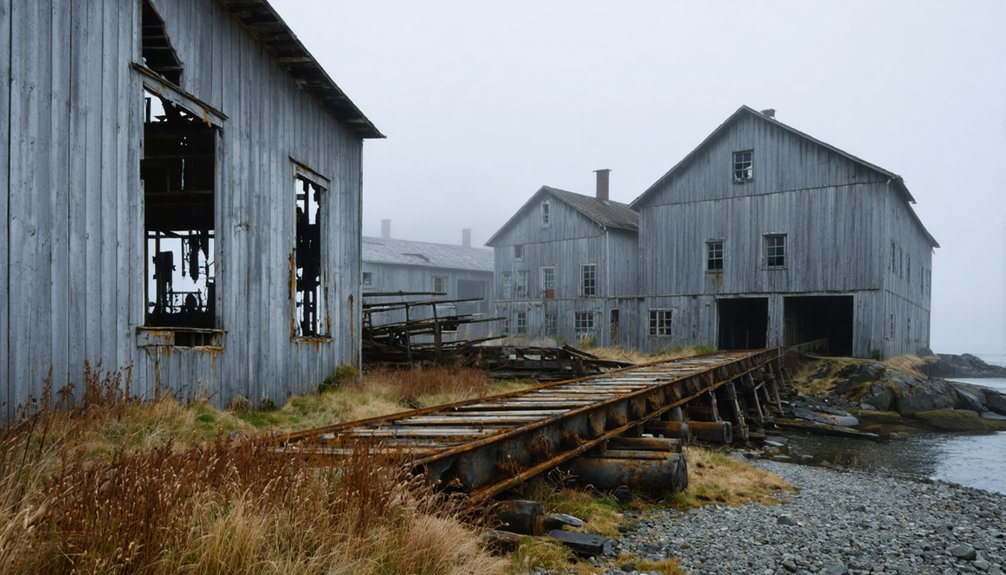
Between the early 1900s and 1950s, Portlock’s residents faced an escalating series of terrifying events that ultimately drove them to abandon their homes en masse.
The community’s cultural fears centered on Nantiinaq, a half-man half-beast creature blamed for violent attacks and mysterious disappearances.
This shared dread shaped the community mindset, especially after tragic incidents like Albert Petka’s fatal encounter in the 1920s.
Physical Remains and Forgotten Structures
Standing as silent witnesses to Portlock’s haunting past, scattered wooden buildings and rusting cannery equipment dot the remote Alaskan landscape where a thriving community once existed.
Today, you’ll find these abandoned structures slowly surrendering to nature’s relentless grip, with most buildings unsafe for entry.
The industrial heritage of this ghost town remains visible through:
The harsh Alaskan elements continue their assault on what’s left, with rain, snow, and wind accelerating decay.
While some privately owned cabins endure, most of Portlock’s remains lie in various states of collapse, accessible only by boat through the surrounding wilderness that’s steadily reclaiming its territory.
Cultural Impact on Native Communities
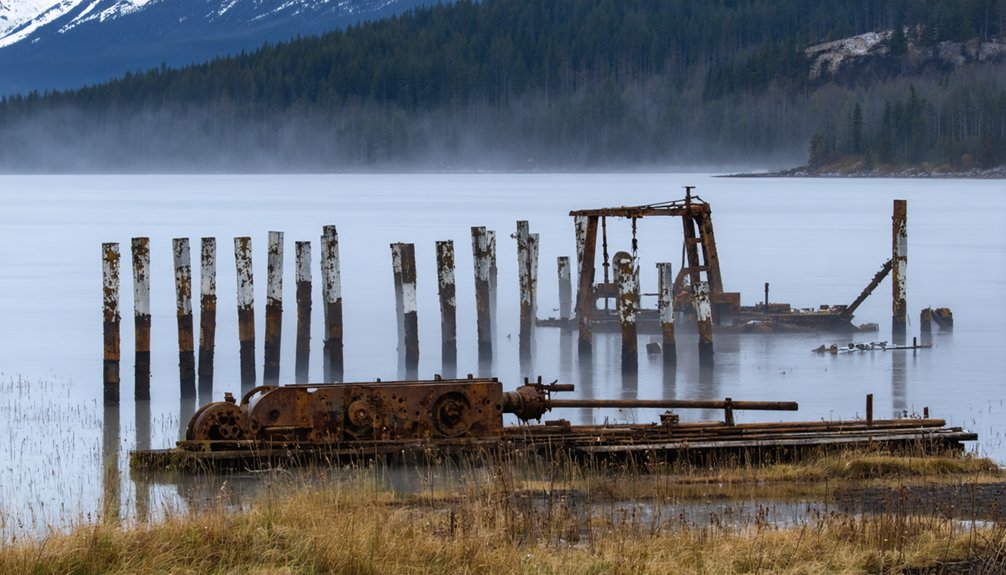
Through generations of cultural heritage, the Sugpiaq people established deep roots in what would later become Portlock, known in their language as Arrulaa’ik.
You’ll find their cultural resilience reflected in the way they preserved their traditions even after relocating to nearby communities like Nanwalek and Port Graham.
When Portlock’s abandonment forced an identity transformation, the Sugpiaq people adapted while maintaining their core values.
They’ve woven their stories, including tales of the mysterious Nantiinaq, into the fabric of their relocated communities.
Today, you can witness their enduring legacy in the continued practice of traditional subsistence activities and the preservation of their language.
Their successful integration into new settlements demonstrates how Native communities have remained strong despite geographical changes, enriching the cultural tapestry of the Kenai Peninsula.
Modern-Day Ghost Town Legacy
When you visit Portlock today, you’ll find a haunting tribute to Alaska’s cannery era nestled along Port Chatham bay’s southern edge. This remote ghost town tourism destination holds both natural wonders and mysterious legends, with the Nantiinaq folklore adding to its haunting allure.
Environmental preservation has allowed nature to reclaim the landscape, where moss-covered ruins tell stories of a once-thriving community.
Despite its isolation, Portlock’s legacy endures through its pristine wilderness and the enduring mysteries that draw curious visitors to its shores.
Frequently Asked Questions
How Can Visitors Safely Access Portlock Today?
You’ll need to charter a boat or seaplane from Seldovia for safe travel to this ghost town. Bring emergency supplies, respect private property rights, and consider hiring experienced local guides.
What Specific Wildlife and Plant Species Are Found Around Portlock?
With over 50 species in a single square mile, you’ll find remarkable wildlife diversity around Portlock: brown bears, sea otters, bald eagles, harbor seals, and plant adaptations like spruce and lichens.
Are There Any Surviving Photographs of Portlock During Its Peak Years?
You won’t find any verified historic images from Portlock’s peak years. While community life was documented through written accounts and oral histories, photographic evidence from its active period remains significantly absent.
What Temperatures and Weather Conditions Are Typical in Portlock Throughout the Year?
Like nature’s roller coaster, you’ll experience climate patterns ranging from mild summers around 70°F to frigid winters below zero. Spring and fall bring moderate temperatures with frequent rain and seasonal variations in daylight hours.
Have Any Archaeological Excavations Been Conducted at the Portlock Site?
You won’t find official archaeological findings here – no large-scale excavations have been conducted. While enthusiasts visit the ruins and document surface artifacts, professional excavation techniques haven’t been applied to this site.
